Story and Photos by Alan Boe
All old Ferraris have a story to tell but most never get the words out. That, however, is not the case with the magnificent little 166 MM Touring-bodied barchetta, s/n 0010 M, which had its story told twice in Cavallino and in the September 1996 edition of Classic and Sports Cars. It’s worth another look because this one of the most important Ferraris of them all. Ferrari historian and Pebble Beach Judge Alan Boe relates the story.
You may be surprised to find out what it’s like driving an early Ferrari. But before we get into the cockpit, let’s review some pertinent statistics that shed light on the performance and handling characteristics.
The lightweight all aluminum body is carried on a multitubular steel alloy Gilco chassis with a 2,200mm (86.6inch) wheelbase, the front suspension is independent via a lower transverse leaf spring, unequal length A-arms, and Houdaille shocks, while the live rear axle works with semi-elliptic leaf springs, parallel trailing arms, and Houdailles. Brakes are hydraulically activated finned drums front and back, the wheels are 4.50 by 15 inch Rudge-Whitworth Borranis, and tires are 5.50 by 15 inch all around.
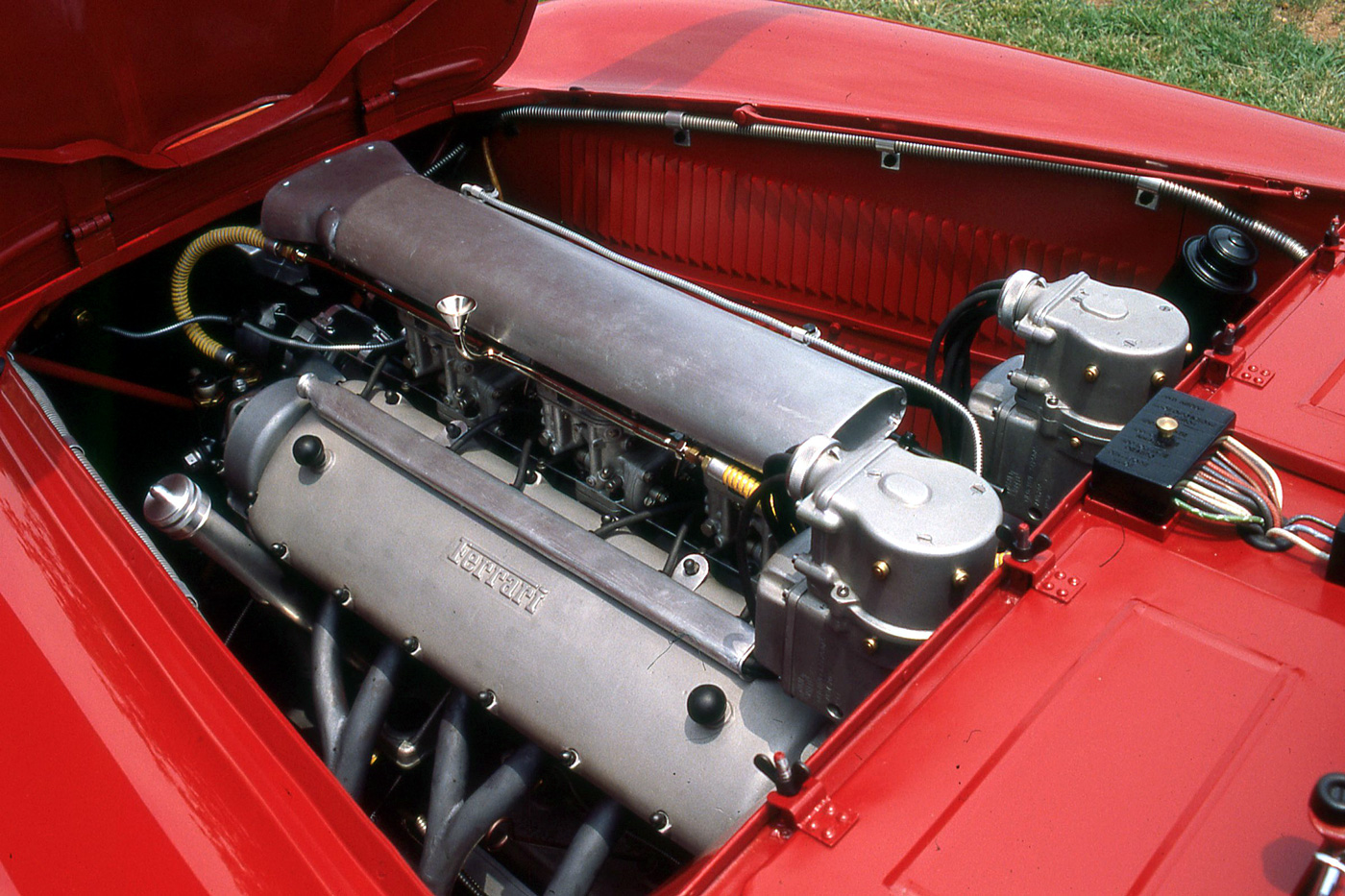
Three 32 DCF Webers are mostly hidden under the rather crude air intake box, which is the most unaesthetic aspect of the 166 MM engine.
The sixty degree single overhead cam V-12 displaces 1,995 cc, or 121.7 CI, and is good for 140 bhp at 7000 rpm. Fuel and air are mixed by a trio of 32 DCF Webers, ignition is via a pair of Magnelli 12 volt magnetos, and the compression ratio per cylinder is 8.5 to 1. Power is fed through a single dry plate clutch to a five speed, plus reverse, gearbox where fifth is overdrive and directed to the rear wheels by a 4.89 to 1 final drive. The barchetta measures 142.5 inches in length, 60 inches in width, stands just over a yard tall at the cowl, and weights a mere 1,433 lbs dry. A 26.4 gallon beautifully riveted fuel tank is located behind the spare tire in the trunk.
The barchetta was a ground breaking, seminal design for Touring and Ferrari. Carlo Anderloni, who was in charge of Touring at the time, has acknowledged that both he and Enzo Ferrari were involved with the design details, with both of them seeking to break new ground with the car’s styling, As a result, the new barchetta became the first sports cars to be wider halfway up the body sides instead of at the sills – revolutionary at the time. The barchetta was a remarkable design then and still is today, small and low yet purposeful. Nothing in excess and all business from the impressive grille and aggressive hood scoop to the lightly tapered rear deck and tail.
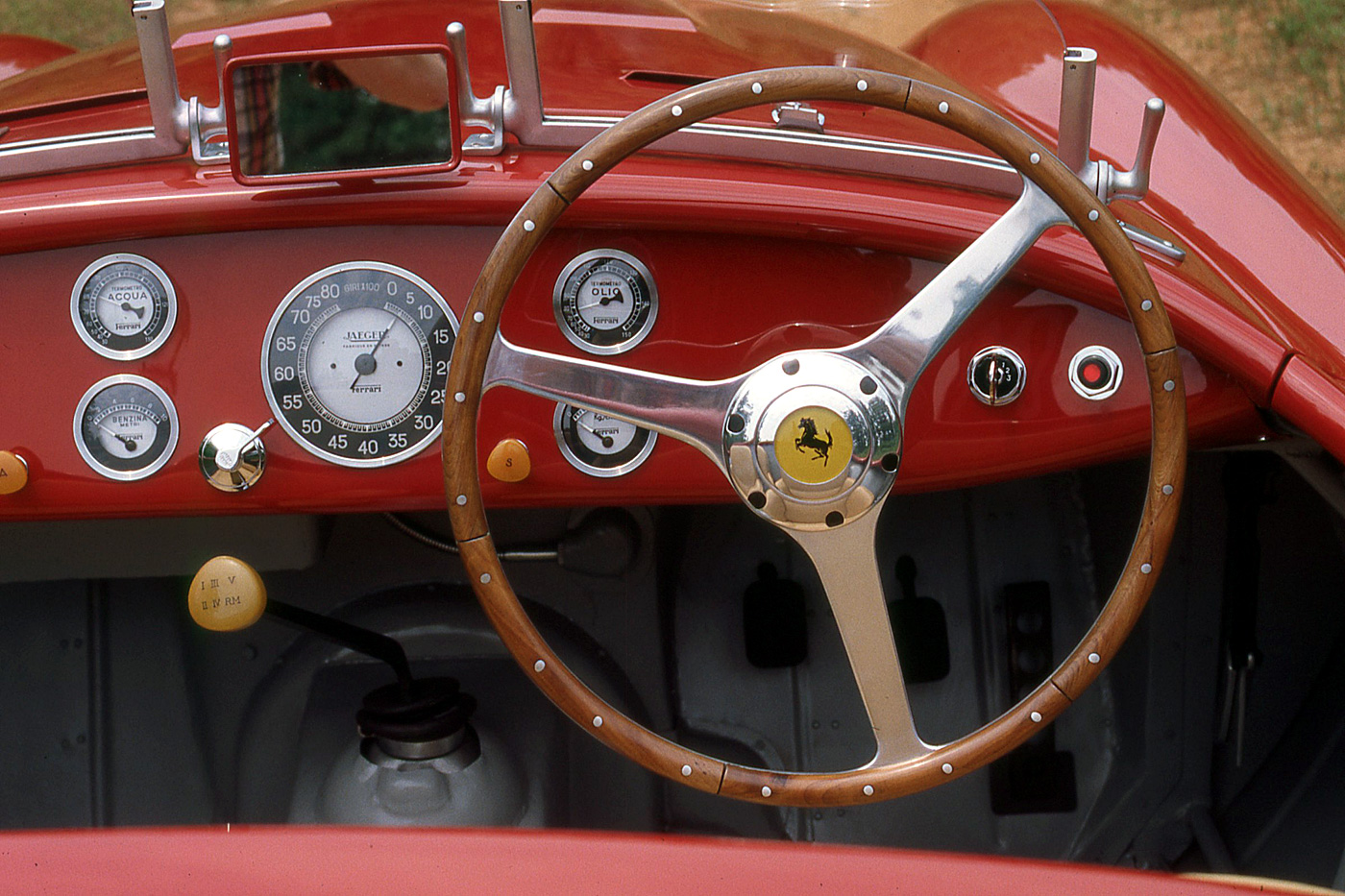
Chinetti and Bonetto drove the 166 MM relying on these instrutments to get them through the 12 Hours at Spa and the Mille Miglia. Just enough information for the drive.
Clustered in the center of the painted dashboard are five Jaeger instruments – a big tach, redlined at 6000 rpm, sits beneath the rear view mirror with water temperature and fuel pressure dials to the left and oil temperature and oil pressure dials to the right. The magneto switch is to the lower left of the tach, and the lower right is the choke knob. The ignition key and starter button are sited in the far right corner of the dash. The Le Mans driving lights are controlled via a switch located to the left of the knob for the cold air duct. A long gearstick, which juts up from the carpet-less floor is topped by a Bakelite knob inscribed with Roman numerals I to V and RM for reverse.
Driving the 166 MM
So what’s it like from behind the steering wheel? Getting started can be interesting. The barchetta was built without an electric fuel pump, so if the car has been sitting for a few days, it becomes necessary to manually prime the fuel log at the top since the mechanical fuel pump will not deliver fuel up to a dry fuel log.
Like all early Ferraris, it’s an understeerer according to owner Jon Shirley. Because the car weighs so little, the steering is light, at least when compared to later big engined Ferraris, and very responsive, so much so that extra care is required, particularly in high speed corners if you’re not sliding the back end around, because even the slightest steering input will cause a large response. Shirley has discovered the fastest way through most corners is to turn in early and then feed in slight changes with the steering wheel while controlling the drift with the throttle. If cornered hard enough, the inside front wheel will start pawing at the air. Dial in dozens of corners and hundreds of gear shifts during the course of a race and driver fatigue will set in – a testimony to the conditioning and great upper arm strength of those who raced barchettas for hours on end in their heyday.
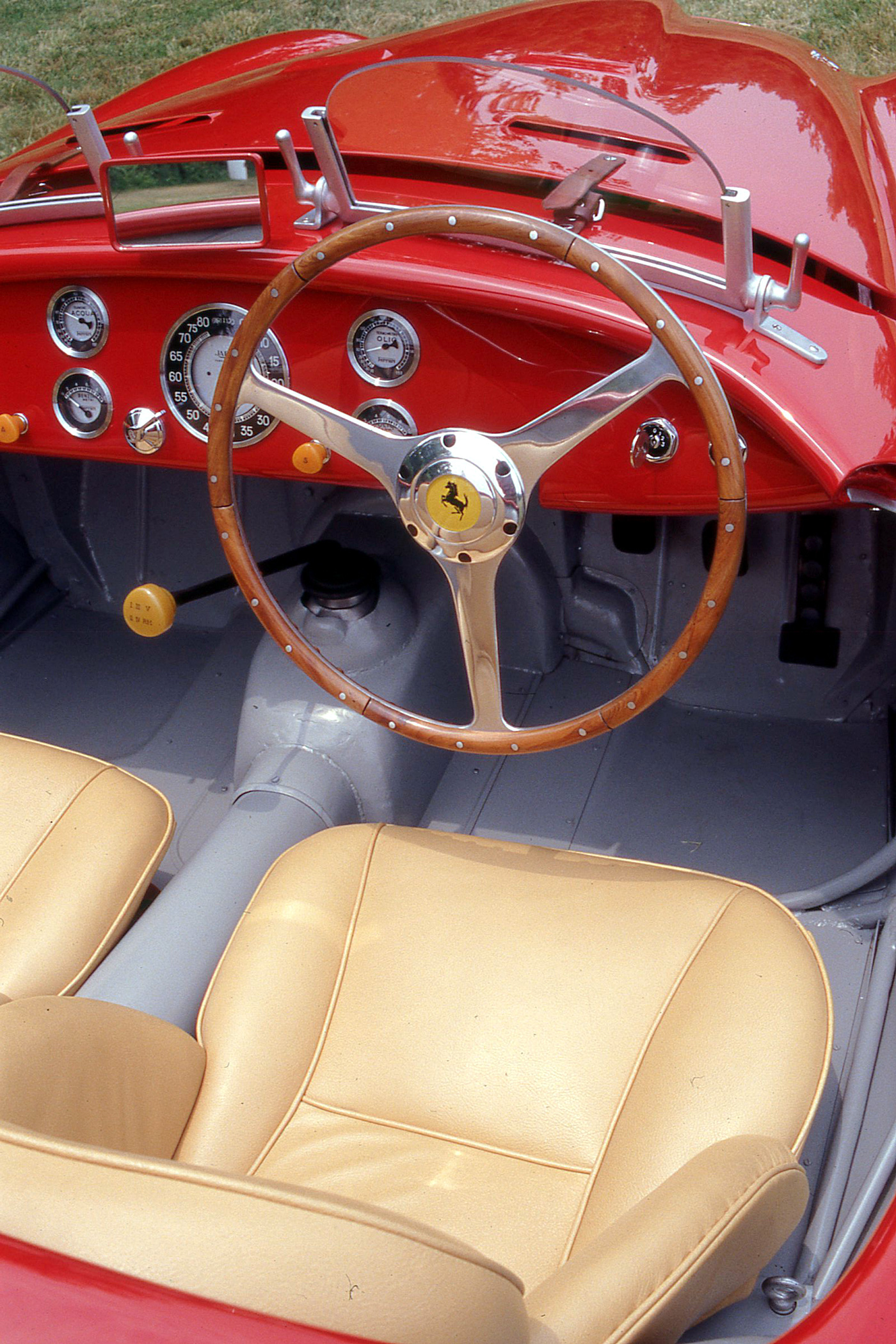
Imagine putting in 12 hours at Spa in the rain, sitting in this open cockpit. Or doing the Mille Miglia over still rough post war roads. Tough guys indeed.
The brake pedal requires a fair amount of pressure under racing conditions to lose speed, even though modern shoes and linings are used, so in the old days a much greater push would have been required to slow down, another fatigue factor. Double clutching is recommended on all downshifts because of the straight cut gears, and is mandatory if you are grabbing for any of the three lower gears. Double clutching also works best on upshifts from first to second to third – trying it without double clutching requires perfect timing.
0010 M European History
As we stated, 0010 M is a car that deserves to have its story told more than once. Its history is fascinating on both side of the Atlantic and exemplifies both the successes and fates of early Ferraris.
Often thought of as the first Ferrari sports car, the 166MM barchetta was actually preceded by Ferrari’s two Auto Avio Construzioni 815 from 1940 and by the 125 and 159 Sport built in 1947. The first racing victories for the 166 series come in in 1948 with Sport, Corso and Coupe examples bodied by Allemano recording wins in the combined Targa Floria/Tour of Sicily, in the Mille Miglia, and in the Paris 12 Hour race at Montlhéry. But it’s fair to say that the 166 MM, introduced in late 1948 with open coachwork by Touring and christened “barchetta” by Giovanni Canestrini writing for the Gazetta Dello Sport, put Ferrari’s name on the map. The following year 166 MM Touring barchettas returned to wins in the Mille Miglia, the Luxembourg Grand Prix, the 24 hours of Le Mans, and in the 24 hour race at Spa-Francorchamps in Belgium. Ferrari’s two liter V12, whether raced as a sports car or as a Formula Two monoposto, reigned supreme in Europe in 1949.
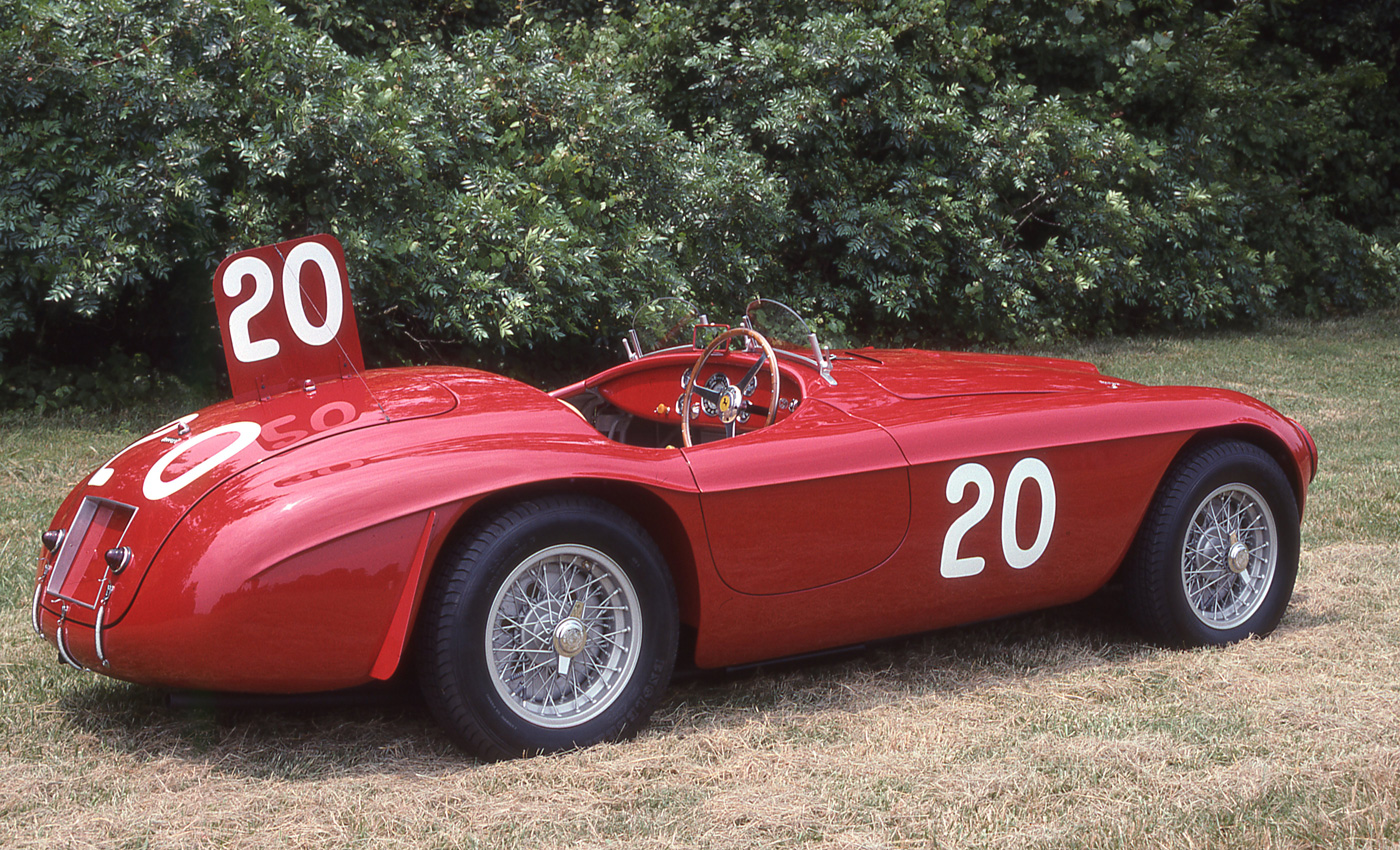
The fin was bolted and wired to the rear deck so that the race stewards could see the number easily during the 24 hour event.
The first two 166 Ferraris to receive coachwork by Touring were introduced to the public on September 14, 1948, at the Salone dell’Automobile in Turin, Italy. A four passenger coupe, s/n 005 S, appeared in the coachbuilder’s enclosure and a barchetta, s/n 0002 M was displayed on Ferrari’s stand. Before the 166 MM gave way to the 2.3 liter 195 series in 1950, Touring, in addition to the barchettas, would provide berlinetta bodies for both long and short wheelbase chassis (plus that 2+2 body) for Ferrari’s little two liter V12. But it was the Touring bodied barchetta (‘little boat’ in Italian), beginning with its wins in 1949, that captured the hearts of a fledging collection of Ferrari tifosi, a feeling that has continued unabated.
Become a Premium Subscriber to VeloceToday! Click here.
Not that all 166 MM Touring barchettas were supposed to be race cars. Ferrari also built a lusso, or luxury version of the Touring barchetta but no windows or side curtains were offered, nor was a folding top or hardtop available, and the windscreen was hardly more than the low cut version found on the racing models. The more generous use of leather in and around the interior seems to be the only lusso contribution. Nor were Touring berlinetta or barchetta bodies limited to the 166 series (the 166 number comes from the approximate displacement in cubic centimeters of one cylinder of the two liter motor). The same sleek lines were used by Ferrari and Touring to cloth some of the 2.3, 2.5, 3.3 and 4.1 liter cars, and one 2.7 liter 225 model, s/n 0166 ED was also bodied by Touring in the barchetta style. Quite a plateful!
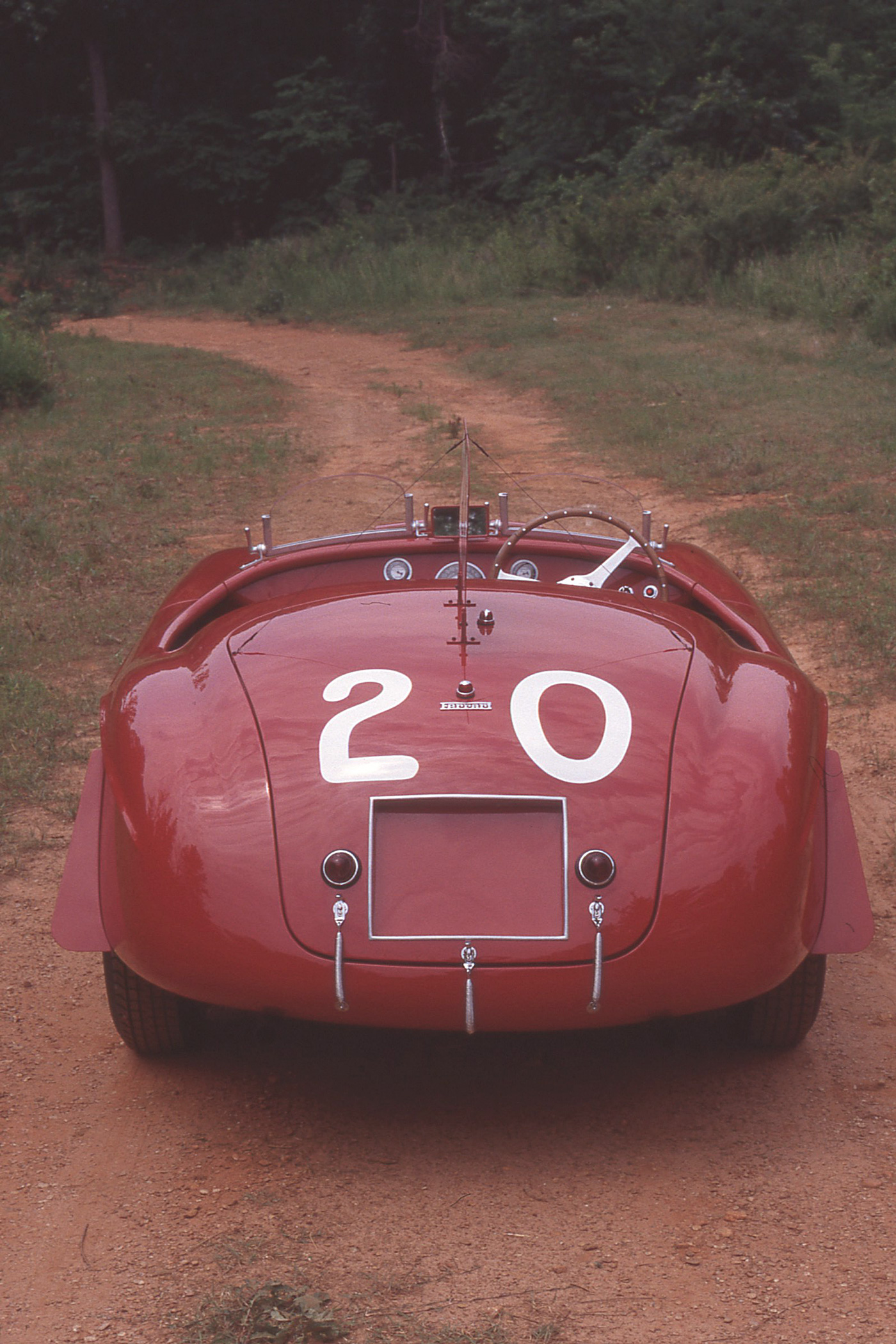
Aside from the somewhat jarring license plate box, there are no straight lines on the Touring body and every line is almost perfect. Was then, is now.
All told, twenty five 166 MM barchettas and five berlinettas were originally produced by Touring, each one slightly different from all the others, but the two most successful on Europe’s race tracks during that 1949 seaon were barchettas, chassis s/n 0008 M and s/n 0010 M. The former came home first in both the Mille Miglia (Biondetti/Salani) and in the 24 Hours of Le Mans (Chinetti/Selsdon) while the latter, although battered two laps from the finish, was victorious in the Spa-Francorchamps 24 hours (Chinetti/Lucas) and finished second in the Mille Miglia (Bonetto/Carpani). A third barchetta, s/n 0012 M, captured the 1949 Luxembourg Grand Prix (Villoresi) as well as lesser races in August at Senigallia, Italy and Trieste in September.
Read Part 2 0010 M in America
This story originally appeared in Cavallino #117 and is published with permission


Very nice!
Mr Boe…….there is nothing crude about the air intake box…..it is a beautifully crafted piece of metalwork. The 166 Barchetta is a sensuous yet pragmatic motorcar designed with competition in mind. Ferrari had the right idea from the word go…..make the car go and make it look good. That is what Ferrari’s reputation is built on!!
Absolutely beautiful car! I love those smooth lines. And Ferrari red, to boot. Definitely a drool-worthy machine. Thank you for sharing!